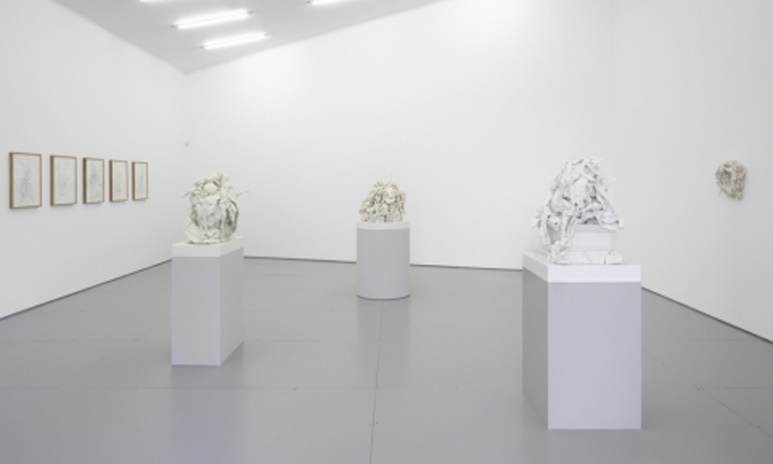British artist Rachel Kneebone talks porcelain, inspiration and creative practice

Rachel Kneebone. (Photo: Courtesy of David Bebber)
British artist Rachel Kneebone is making her Asia debut this month with Ovid in Exile, an exhibition of new works at White Cube gallery that opens on Saturday May 27 and runs until August 19.
Ahead of the show, we caught up with the artist, who is known for intricate porcelain works that explore what it means to be human, the body’s physical limitations and its cognitive possibilities.
See also: Christo On Living In The Moment
Your work tackles themes of death, life, renewal and life cycles. Were you always drawn to these subjects? Are they the driving force in your artistic process?
Yes. The themes at the core of my work are regeneration, renewal, transformation and growth and the experience of inhabiting the body. The work explores metamorphosis, beginnings and endings, and the creative process through which one thing becomes something else.

Rachel Kneebone's previous exhibition at White Cube Glyndebourne, East Sussex (Photo: Courtesy of George Darrell/White Cube)
Does porcelain speak to you as a material, and why?
Practically speaking I think my work comes from my ongoing dialogue with porcelain. The longer I work with the material, the more I experience, the more I learn about its capabilities and its boundaries. This has a direct impact on how I work with it and what I can create; it is the means by which to give form to feeling.
Do you look at art history as an influence in your work? How much of it seeps through your practice?
Literature, art history, film, tv, dance, shopping, being out with friends, being alive in the world are all things that are part of what I do. My work is not a direct result of any one element, it is tied up in everything that has happened and is happening during the making of it.
This will be your first exhibition in Asia. Are you familiar with the local art scene?
I have never visited Asia before so its local art scene is something I am looking forward to experiencing and connecting with during my time in Hong Kong.

Rachel Kneebone, Daphne, 2015 (Courtesy of White Cube gallery)
Ovid in Exile showcases new works. How long did you work on them, and when did you first develop the idea for the exhibition?
Ideas around metamorphosis and transformation are key to my practice: conceptually and as part of the process of working with porcelain, which undergoes its own metamorphosis, from wet to dry to its fired state during the making of the works. At each stage of the process the material transforms.
Read more: China's Andy Warhol On Abstract Inspiration
Following a conversation I had in my studio with collectors from Asia, I decided to focus on this element of my work and to isolate thoughts around metamorphosis. Asia has a strong tradition of working with porcelain, of course, and the collectors and I discussed how my work challenged perceived knowledge and expectations of this material, granting it a new freedom.
I liked the idea of doing a show that would explore and present work that was familiar in its material, but at the same time, perhaps unfamiliar through my handling of it. It took me roughly six months of making to form the body of work for Ovid in Exile.

Rachel Kneebone, Pupa, 2016, courtesy White Cube gallery
Guide us through some key aspects of Ovid in Exile so our readers know what to expect from the exhibition.
Ovid in Exile moves around ideas of transformation, renewal and change. In a literal sense, through form, body or flesh to stone, and also more abstractly.
I feel it is a very human and accessible presentation. The state of metamorphosis is something we are all familiar with; it could be argued that to be alive is to be in a constant state of metamorphoses. Everyday, through our experiences of being alive in the world, we have the capacity to become someone else, to change, learn and grow.
One of your works, 399 Days, is currently on display amongst other masterpieces as part of the Victoria & Albert Museum’s sculpture collection in London. How does that feel?
The V&A has always been a very important place for me. Within its walls it houses objects from many different cultures, traditions and times, allowing us to experience in one single place a collage of human endeavour.
399 Days is placed within the Medieval and Renaissance galleries, which allows it to resonate with the figurative sculpture and architectural forms around it, coexisting in a historical context and creating dialogues with the V&A collections. To me, having those dialogues is incredibly important.
In an era of VR-led art, multi-media installations and digital creativity, what’s the future of sculpture?
I think the future of sculpture is unchallenged by any and all other means of expression. As long as there is civilization there will be the compulsion to make.
Ovid in Exile, May 27 to August 19, White Cube gallery, 50 Connaught Road Central, +852 2592 2000, whitecube.com
Like this story? Sign up for our weekly newsletter to get our top tatler_stories delivered.
See also: 8 Must-See Artists At The Venice Biennale 2017
